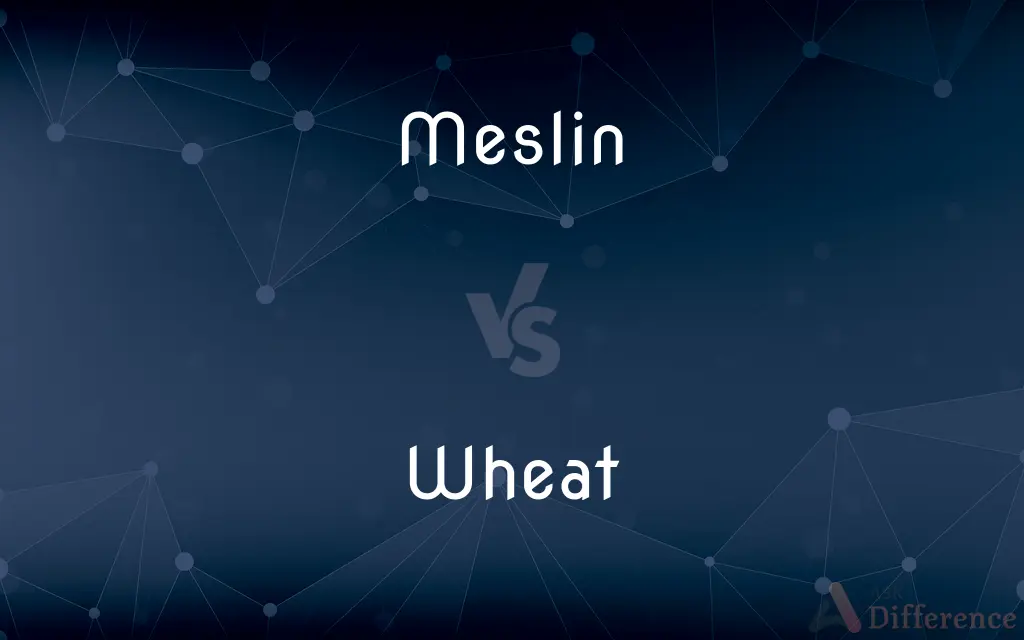Meslin vs. Wheat — What's the Difference?
Edited by Tayyaba Rehman — By Urooj Arif — Updated on March 22, 2024
Meslin, a blend of wheat and rye grown together as a mixed crop, offers a unique flavor and nutritional profile, while wheat, a globally dominant cereal crop, is prized for its versatility in food production.

Difference Between Meslin and Wheat
Table of Contents
ADVERTISEMENT
Key Differences
Meslin, also known as maslin or mixed grain, is an age-old agricultural practice of growing wheat and rye together. On the other hand, wheat stands as a singular grain crop that has been selectively bred over millennia to optimize yield, quality, and disease resistance. Wheat flour is a staple ingredient worldwide, known for its versatility in baking, cooking, and manufacturing a wide range of food products.
The cultivation of meslin reflects traditional farming methods that leverage biodiversity to enhance soil health and reduce the risk of crop failure. This mixed cropping approach can offer environmental benefits, such as reduced pest and disease pressure and improved weed management, without relying heavily on chemical inputs. Conversely, modern wheat cultivation often involves monoculture practices, heavily dependent on synthetic fertilizers and pesticides. Although this enhances productivity and ensures a consistent supply, it raises concerns about sustainability and environmental impact.
Meslin's flour is valued for its complex flavor profile, blending the robustness of rye with the mildness of wheat. This makes meslin breads richly flavored and nutritious, containing a higher fiber content and a broader range of minerals than breads made solely from wheat. Wheat flour, however, is preferred for its gluten content, which gives bread and other baked goods their structure and texture. The high gluten content in wheat makes it indispensable for producing a wide variety of foods, from pastries and pasta to cereals and sauces.
In terms of nutritional value, meslin offers a more diverse nutrient profile due to the combination of wheat and rye. It tends to be higher in fiber, vitamins, and minerals, contributing to better digestion and overall health. Wheat, while also nutritious, primarily provides carbohydrates, protein, and fiber, with its nutritional quality varying significantly across different varieties and processing methods.
The market demand for meslin is niche, catering to consumers seeking traditional or whole-grain breads with unique flavors and nutritional benefits. This contrasts with the global dominance of wheat, which is a cornerstone of diets worldwide, driven by its adaptability to a wide range of culinary applications and consumer preferences.
ADVERTISEMENT
Comparison Chart
Definition
A mixed grain of wheat and rye
A cereal grain used globally
Cultivation
Traditional mixed cropping
Often monoculture farming
Flavor
Robust, due to blend of grains
Mild, versatile for various foods
Nutritional Value
Higher fiber, vitamins, minerals
High in carbohydrates, protein, gluten
Environmental Impact
Reduced due to biodiversity
Concerns over sustainability with monoculture
Compare with Definitions
Meslin
Employs mixed cropping methods.
The farmer planted meslin to improve soil health.
Wheat
Provides a mild, adaptable taste.
Wheat flour is preferred for its versatility in recipes.
Meslin
A blend of wheat and rye grown together.
Meslin flour was used for a richly flavored bread.
Wheat
A single grain crop essential in global diets.
Wheat flour is a staple in baking and cooking.
Meslin
Known for its unique, robust flavor.
The artisan bakery specializes in meslin loaves.
Wheat
Dominated by high-yield monoculture.
Modern wheat varieties are bred for disease resistance.
Meslin
Offers a diverse nutrient profile.
Meslin is praised for its higher fiber content.
Wheat
Rich in carbohydrates and protein.
Wheat is a fundamental source of nutrition worldwide.
Meslin
Benefits from reduced chemical inputs.
Meslin cultivation supports biodiversity in farming.
Wheat
Raises sustainability concerns.
Intensive wheat farming demands significant water and pesticides.
Meslin
Meslin (French pronunciation: [mɛlɛ̃]; Breton: Melin) is a former commune in the Côtes-d'Armor department of Brittany in northwestern France. On 1 January 2016, it was merged into the commune Lamballe, which was merged into the new commune Lamballe-Armor on 1 January 2019.
Wheat
Wheat is a grass widely cultivated for its seed, a cereal grain which is a worldwide staple food. The many species of wheat together make up the genus Triticum; the most widely grown is common wheat (T. aestivum).
Meslin
Alternative form of maslin
Wheat
A cereal which is the most important kind grown in temperate countries, the grain of which is ground to make flour for bread, pasta, pastry, etc.
Meslin
See Maslin.
Wheat
Any of various annual cereal grasses of the genus Triticum of the Mediterranean region and southwest Asia, especially T. aestivum, widely cultivated in temperate regions in many varieties for its commercially important edible grain.
Wheat
The grain of any of these grasses, ground to produce flour used in breads, pasta, and other foods.
Wheat
(countable) Any of several cereal grains, of the genus Triticum, that yields flour as used in bakery.
Wheat
(uncountable) A light brown colour, like that of wheat.
Wheat
Wheaten, of a light brown colour, like that of wheat.
Wheat
A cereal grass (Triticum vulgare) and its grain, which furnishes a white flour for bread, and, next to rice, is the grain most largely used by the human race.
Wheat
Annual or biennial grass having erect flower spikes and light brown grains
Wheat
Grains of common wheat; sometimes cooked whole or cracked as cereal; usually ground into flour
Common Curiosities
Can Meslin flour be used like Wheat flour in cooking and baking?
Yes, meslin flour can be used in cooking and baking, offering a richer flavor and nutritional profile, but it may require adjustments due to its different gluten content.
What are the nutritional benefits of Meslin compared to Wheat?
Meslin tends to be higher in fiber, vitamins, and minerals due to the combination of wheat and rye, offering diverse health benefits.
How does the taste of Meslin bread compare to Wheat bread?
Meslin bread has a more robust and complex flavor compared to the milder taste of wheat bread, appealing to those seeking depth in their baked goods.
How does Meslin differ from Wheat in cultivation?
Meslin utilizes mixed cropping, enhancing soil health and biodiversity, whereas wheat is often grown in monocultures, focusing on yield and consistency.
Is Meslin readily available in markets like Wheat?
Meslin is less commonly found than wheat, catering to a niche market of consumers seeking traditional or whole-grain products.
How do Meslin and Wheat contribute to dietary diversity?
Meslin adds dietary diversity with its unique nutritional profile and flavor, while wheat provides a foundational carbohydrate source for varied diets.
Why is Meslin considered more environmentally friendly than Wheat?
Meslin's cultivation benefits from natural pest and disease resistance through biodiversity, reducing the need for chemical inputs compared to wheat's monoculture farming.
What is Meslin?
Meslin is a mixed grain crop, consisting of wheat and rye grown together, known for its unique flavor and nutritional benefits.
Can growing Meslin benefit small-scale farmers?
Yes, meslin can benefit small-scale farmers by improving soil health, reducing pest and disease risks, and offering a unique product to the market.
Why is Wheat more popular globally than Meslin?
Wheat's versatility, adaptability to different culinary uses, and the consistency of its supply have made it a global staple, overshadowing niche grains like meslin.
Share Your Discovery

Previous Comparison
Outputted vs. Output
Next Comparison
Integrated vs. IntegralAuthor Spotlight
Written by
Urooj ArifUrooj is a skilled content writer at Ask Difference, known for her exceptional ability to simplify complex topics into engaging and informative content. With a passion for research and a flair for clear, concise writing, she consistently delivers articles that resonate with our diverse audience.
Edited by
Tayyaba RehmanTayyaba Rehman is a distinguished writer, currently serving as a primary contributor to askdifference.com. As a researcher in semantics and etymology, Tayyaba's passion for the complexity of languages and their distinctions has found a perfect home on the platform. Tayyaba delves into the intricacies of language, distinguishing between commonly confused words and phrases, thereby providing clarity for readers worldwide.














































